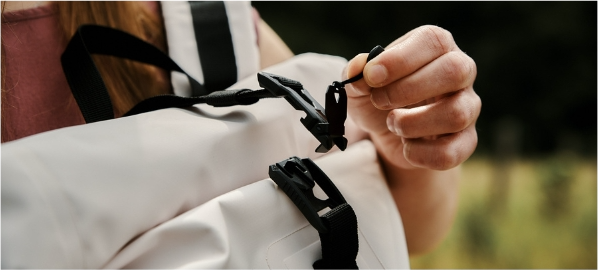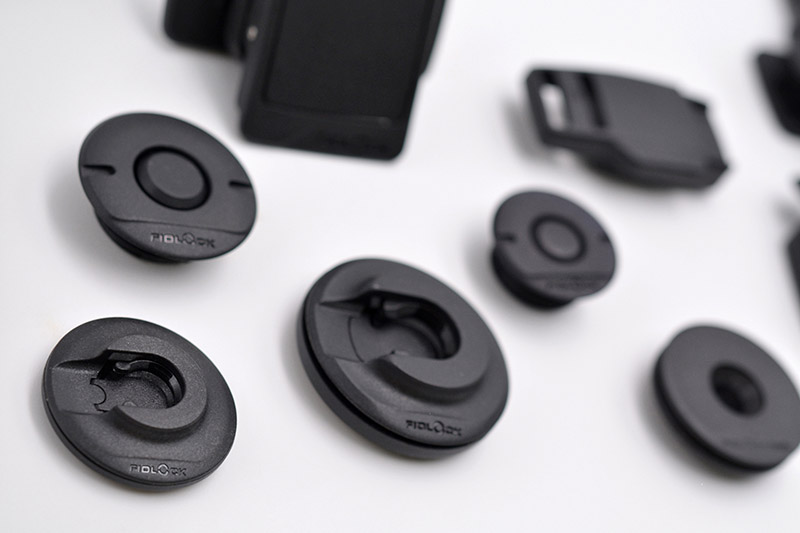
FIDLOCK design DNA:
Inventive spirit with recognisable value
A recognizable design language expresses our inventive spirit.
Textabschnitt "Unsere Leidenschaft"
Our passion at FIDLOCK is to use our inventive spirit to turn everyday opening, closing and fastening into a unique experience. Over the years, our team has developed countless fastening solutions for various applications. With this ever-increasing number of products, new challenges arose for us: How can we give our product portfolio a visible cohesion and a formal independence that does not come at the expense of versatility?
Together with the design studio Rudolph Schelling Webermann (RSW) from Hanover, we tried, tested and pondered for over a year - and are delighted to present the FIDLOCK design DNA.
Textabschnitt "Die Frage nach dem „Warum“? "
The question of "why"?
FIDLOCK can be found almost everywhere in everyday life - e.g. on helmets, bags, shoes and bicycles. The number of our catalogue fasteners already reached the three-digit range. In addition, there are HERMETIC, the bicycle components and as well as our special developments for our customers. Every industry and every product designer have particular requirements. Accordingly, our product portfolio is also very colourful and includes different design languages.

Textabschnitt "Die neue Design-DNA"
A unifying concept
The new design DNA creates a shape to underline our brand identity and is recognisable at first glance: This is a FIDLOCK original. We want to fulfil the requirements of the various application areas not only with technical terms but also aesthetically in the best possible way. With the Design DNA, we have developed a concept that brings our product portfolio closer together in formal terms and still allows it to be customised to the most diverse target groups in terms of design.
The FIDLOCK design DNA on the product
To enable the necessary versatility, two different design lines are defined in our design DNA: One line is created to be more dynamic, angular and technical in its expression and can better serve the sporting sector. The other line takes elegant and softer directions. Therefore, it is ideally suited to areas from child safety to clothing.
In addition to overarching design rules, the core element of our design DNA is the "Shifted Edge", a unifying detail. It ensures formal cohesion across both lines. This design tool is the perfect instrument to give our products a unique and recognisable feature while not restricting the creative and inventive minds of our development engineers and designers.
The "Story Behind" in an interview with FIDLOCK and RSW: A project that connects on various levels.
FIDLOCK and RSW have invested a lot of time, effort and passion into the development of the FIDLOCK Design DNA. To get a deeper dive into the process and the development of the concept behind the Design DNA, we spoke to Esther, Head of Design at FIDLOCK, and to Sven and Carsten from the RSW design studio in an interview.
Interview Teil 1
Esther, why an external partner for this project?
Esther (FIDLOCK): The basic idea was that we needed someone who could think “out of the box”, act independently of our established development standards and look at our products from the outside.
RSW, what is the advantage of working on a project like this as an external partner?
Carsten (RSW): Daily contact with a topic over a long period results in in-depth expertise. This expertise is valuable, but it could also mean that I exclude things from the outset because I'm convinced they won't work. Casually: a kind of operational blindness. As an outsider, you don't have these looks on and can ask completely new questions and have a better view of the big picture. We have utilised this effect. We were able to explore the limits of what could be realised and managed to create an independent design DNA by working closely with FIDLOCK.

What were the first steps that you, RSW, took, and how did you approach the topic of FIDLOCK and FIDLOCK design?
Sven (RSW): In the beginning, we did a lot of research. Firstly, we had to understand the FIDLOCK brand itself. What kind of products are there? What are the people like, and what is the philosophy or mindset of this company? In my opinion, a company has a personality, and this personality must mirror the design of the products. You also have a unique founding story that lives on in this company. By taking such a comprehensive view, you understand better how and what the brand is.
Secondly, we looked at your markets and evaluated what the products that use the fasteners look like. The design of the buckles should adapt to this. We also looked at local trends and their development - what will the products look like in 5 or 10 years?
Carsten (RSW): Another essential component of our research was the detailed analysis of your portfolio and the design language of the existing products. Where are the products located? We created a form of coordinate system where we positioned the individual products to find out where the products are located. It allowed us to see whether there were any focal points or whether there were still gaps. The idea of developing two design lines resulted from this analysis.
Surveys were an equally important aspect. We spoke to customers, distributors and end users on a random basis. That gave us a good outline of the external view of FIDLOCK.

Interview Teil 3
Although our product portfolio originated on magnetic-mechanical connections, it is very diverse due to the many possible applications. How did you deal with this diversity?
Sven (RSW): We quickly realised that the entire subject became very complex. There are so many different markets and various products with individual requirements. Some are very small. Some are the size of the palm of your hand. Some are very easy because they are rotationally symmetrical due to the mechanics behind them, and others are more angular. You have to deal with an immense canon of shapes. Afterwards, it was a bit like a puzzle game. You try to find a categorisation where you can work with as few different building blocks as possible. It should remain manageable for the designers, offer enough freedom, and you have to be able to communicate it to the outside world. In principle, the aim was always to create a maximum reduction that can still cover as much as possible.
Esther (FIDLOCK): And even if our products are developed for their area of application and on the type of operation or fastening option, they may be used in an environment where they were not originally intended. There are sectors without strict requirements as in other safety-relevant applications, and in these sectors, the fasteners are used as required. That creates freedom in terms of design.
Let's talk about the FIDLOCK as a brand again. Are there certain aspects that you associate with the design of the products and FIDLOCK's brand identity?
Sven (RSW): I think FIDLOCK, as a brand, provides an incredibleamount of possibilities. There are lots of things that you really want to tell and also incorporate into the design. For example, it was essential to us that the theme of your inventiveness or creativity, which has been there from the start, could also be expressed in the design. We also asked ourselves numerous questions: Can FIDLOCK products be sharp-edged and very angular, or can they be completely shapeless, organic and round-sucked like a pebble? That is also derived from the brand identity, regardless of the markets. Of course, you are not round, shapeless and without tension or contour. But neither are you an aggressive, sharp, hard company where you play hardball.
Carsten (RSW): Exactly, and that's where the idea of two design lines that are different but still fit and come together through the "unifying detail" emerged from. That's what the brand is all about - a togetherness through technology that can now be expressed in the design.
Interview Teil 5
Let's go further into the "unifying detail". Apart from what was already mentioned, is there anything else that contributed to the decision in favour of a "unifying detail" and the implementation as a "shifted edge"?
Sven (RSW): One thing was the logo placement. Initially, the aim of the project was that the customer can recognise the FIDLOCK buckle on a helmet when they buy it because the technology is so exciting. Our idea then was to place the FIDLOCK logo on the main surface. By developing the surface, we "shifted" the logo from the side surface and the edge to the top.
Esther (FIDLOCK): We have now created a recognisable and comparatively even sustainable detail in a prominent area, which nevertheless integrates unobtrusively into the product. And by which the FIDLOCK original can be recognised even without our logo.
Carsten (RSW): What the "Swoosh" is for Nike is now the "Shifted Edge" for FIDLOCK. The dynamic lines also reflect the character of the company.

What was unique about this collaboration for you?
Sven (RSW): The project wasn't the usual way - Normally, we do presentation number one, presentation number two, presentation number three, and then we hand it over - here it was a process in which we threw the balls to each other and worked together. I've never had a collaboration where I felt like a real team member.
Carsten (RSW): Yes, and we also had to deal with the core of the brand. When you develop a luminaire for a company, for example, you don't go as deeply into the soul of a company as we did with this project. We have completely penetrated FIDLOCK. As the knowledge exchange worked so well.
Esther (FIDLOCK): Even when you had the feeling that you had reached a dead end, you always managed to bring in new ideas from outside. You soaked up everything, you put yourselves in our shoes. You understood that we are very different people with different perspectives on the development process and that we had to take all of this into the development process. You were very competent and flexible.
Finally, a look into the future: What will happen now with Design DNA?
Esther (FIDLOCK): We have initiated a huge transformation process with the launch. While new developments are now always designed according to the Design DNA, we also have to keep our customers at the centre of our focus and pay attention to the sustainability and consistency of the processes. Many customers have been integrating our closures and applications with the current design into their products - their brand - for years; we have to plan transition phases in a very structured way. It was also clear to us from the beginning that our goal of strengthening the identity of the FIDLOCK brand with a recognisable design would take a long time and become an ongoing process.
Sven (RSW): We also labelled the process as design DNA 1.0 because we always knew that it would have to evolve. There will always be new learnings in the process and the implementation of further closures. I believe it is the right way to say that this is not set in stone forever, but that the design DNA and the process will continue to be optimised.






